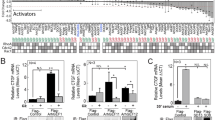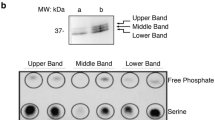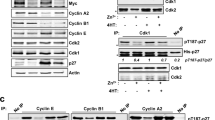Abstract
The T1 gene gives rise to two transcripts encoding a 62 kDa membrane-bound and a 37 kDa secreted protein with similarity to the type I IL-1 receptor. It is weakly expressed in proliferating but not in resting fibroblasts and is strongly induced during the entry of quiescent cells into the cell cycle. Here we show that the T1 gene is also transcriptionally activated in response to the treatment of fibroblasts with cycloheximide and anisomycin. These protein synthesis inhibitors are known to stimulate the JNK and p38/RK signal transduction pathways. We provide evidence that anisomycin triggers T1 gene induction through the stimulation of the p38/RK MAP kinase. This observation is in line with our finding that physiological activators of the p38/RK pathway, the proinflammatory cytokines IL-1 and TNFα, stimulate T1 gene expression efficiently. Growth factor mediated T1 gene induction is a delayed early event, requiring ongoing protein synthesis. In contrast, anisomycin induces T1 gene expression at concentrations which block translation completely. Thus, transcriptional induction of the T1 gene via the p38/RK pathway is an immediate early event not requiring de novo protein synthesis. The T1 gene is strongly induced by various mitogens in quiescent NIH3T3 fibroblasts but not in ras transformed NIH3T3 cells. In contrast, all of the three tested agent which activate the p38/RK pathway, IL-1, TNFα, and anisomycin led to strong T1 gene expression in normal and ras transformed NIH3T3 cells alike. Thus, the T1 gene can be induced through the activation of at least two MAP kinase pathways: signaling through the ERK pathway can occcur in normal but not in ras transformed NIH3T3 cells, whereas the signaling through the p38/RK pathway is not affected by ras transformation.
This is a preview of subscription content, access via your institution
Access options
Subscribe to this journal
Receive 50 print issues and online access
$259.00 per year
only $5.18 per issue
Buy this article
- Purchase on Springer Link
- Instant access to full article PDF
Prices may be subject to local taxes which are calculated during checkout
Similar content being viewed by others
Author information
Authors and Affiliations
Rights and permissions
About this article
Cite this article
Laursen, N., Kessler, R., Fröhli, E. et al. Effects of ras transformation on the induction of the IL-1 receptor related T1 gene in response to mitogens, anisomycin, IL-1 and TNFα. Oncogene 16, 575–586 (1998). https://doi.org/10.1038/sj.onc.1201522
Received:
Revised:
Accepted:
Published:
Issue Date:
DOI: https://doi.org/10.1038/sj.onc.1201522



